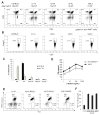Monoclonal Invariant NKT (iNKT) Cell Mice Reveal a Role for Both Tissue of Origin and the TCR in Development of iNKT Functional Subsets
- PMID: 28576977
- PMCID: PMC5518629
- DOI: 10.4049/jimmunol.1700214
Monoclonal Invariant NKT (iNKT) Cell Mice Reveal a Role for Both Tissue of Origin and the TCR in Development of iNKT Functional Subsets
Abstract
Invariant NKT (iNKT) cell functional subsets are defined by key transcription factors and output of cytokines, such as IL-4, IFN-γ, IL-17, and IL-10. To examine how TCR specificity determines iNKT function, we used somatic cell nuclear transfer to generate three lines of mice cloned from iNKT nuclei. Each line uses the invariant Vα14Jα18 TCRα paired with unique Vβ7 or Vβ8.2 subunits. We examined tissue homing, expression of PLZF, T-bet, and RORγt, and cytokine profiles and found that, although monoclonal iNKT cells differentiated into all functional subsets, the NKT17 lineage was reduced or expanded depending on the TCR expressed. We examined iNKT thymic development in limited-dilution bone marrow chimeras and show that higher TCR avidity correlates with higher PLZF and reduced T-bet expression. iNKT functional subsets showed distinct tissue distribution patterns. Although each individual monoclonal TCR showed an inherent subset distribution preference that was evident across all tissues examined, the iNKT cytokine profile differed more by tissue of origin than by TCR specificity.
Copyright © 2017 by The American Association of Immunologists, Inc.
Figures








Similar articles
-
Transnuclear mice reveal Peyer's patch iNKT cells that regulate B-cell class switching to IgG1.EMBO J. 2019 Jul 15;38(14):e101260. doi: 10.15252/embj.2018101260. Epub 2019 May 31. EMBO J. 2019. PMID: 31304630 Free PMC article.
-
NKAP Regulates Invariant NKT Cell Proliferation and Differentiation into ROR-γt-Expressing NKT17 Cells.J Immunol. 2016 Jun 15;196(12):4987-98. doi: 10.4049/jimmunol.1501653. Epub 2016 May 9. J Immunol. 2016. PMID: 27183586 Free PMC article.
-
Defining a novel subset of CD1d-dependent type II natural killer T cells using natural killer cell-associated markers.Scand J Immunol. 2019 Sep;90(3):e12794. doi: 10.1111/sji.12794. Epub 2019 Jun 26. Scand J Immunol. 2019. PMID: 31141185 Free PMC article.
-
T Cell Receptor Expression Timing and Signal Strength in the Functional Differentiation of Invariant Natural Killer T Cells.Front Immunol. 2019 Apr 26;10:841. doi: 10.3389/fimmu.2019.00841. eCollection 2019. Front Immunol. 2019. PMID: 31080448 Free PMC article. Review.
-
Unveiling the regulation of NKT17 cell differentiation and function.Mol Immunol. 2019 Jan;105:55-61. doi: 10.1016/j.molimm.2018.11.013. Epub 2018 Nov 26. Mol Immunol. 2019. PMID: 30496977 Review.
Cited by
-
Tissue-specific shaping of the TCR repertoire and antigen specificity of iNKT cells.Elife. 2019 Dec 16;8:e51663. doi: 10.7554/eLife.51663. Elife. 2019. PMID: 31841113 Free PMC article.
-
Transnuclear mice reveal Peyer's patch iNKT cells that regulate B-cell class switching to IgG1.EMBO J. 2019 Jul 15;38(14):e101260. doi: 10.15252/embj.2018101260. Epub 2019 May 31. EMBO J. 2019. PMID: 31304630 Free PMC article.
-
Cytokine Output of Adipocyte-iNKT Cell Interplay Is Skewed by a Lipid-Rich Microenvironment.Front Endocrinol (Lausanne). 2020 Jul 31;11:479. doi: 10.3389/fendo.2020.00479. eCollection 2020. Front Endocrinol (Lausanne). 2020. PMID: 32849273 Free PMC article.
-
Development of αβ T Cells with Innate Functions.Adv Exp Med Biol. 2022;1365:149-160. doi: 10.1007/978-981-16-8387-9_10. Adv Exp Med Biol. 2022. PMID: 35567746
-
Alcohol consumption induces murine osteoporosis by downregulation of natural killer T-like cell activity.Immun Inflamm Dis. 2021 Dec;9(4):1370-1382. doi: 10.1002/iid3.485. Epub 2021 Jul 2. Immun Inflamm Dis. 2021. PMID: 34214248 Free PMC article.
References
-
- Bendelac A, Savage PB, Teyton L. The biology of NKT cells. Annu Rev Immunol. 2007;25:297–336. - PubMed
Publication types
MeSH terms
Substances
Grants and funding
LinkOut - more resources
Full Text Sources
Other Literature Sources
Molecular Biology Databases

